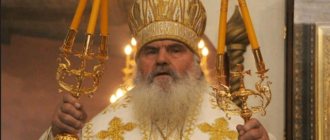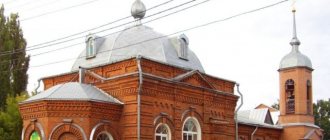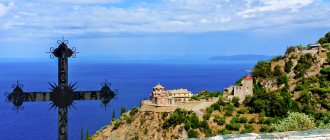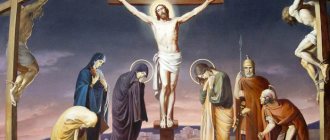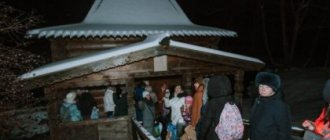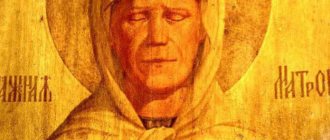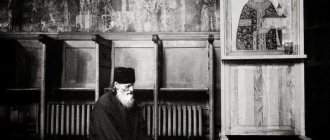Is it possible to live in the past if God gives something new?
Princess Tamara (Reverend Confessor Tamar) was born in Georgia, into a princely family, in 1868.
She grew up in love, luxury and abundance. Her father, Prince Alexander, died when Tamara was a child. Numerous relatives helped Tamara’s mother, who became the most dear person to the princess, in everything.
In her youth, Princess Tamara became seriously interested in music and was preparing to enter the St. Petersburg Conservatory, in which her mother warmly supported her. The girl decided to leave marriage for later, despite the many fans attracted by her bright beauty.
The unexpected death of her beloved mother, when the princess was barely twenty, completely changes the girl’s carefree state of mind.
Sleepless nights in tears, prayers for the repose of my mother’s soul brought questions - why did my mother leave? What is a person? Why does he live, why does he die?
Aunties, uncles, brothers and sisters tried to console Tamara and entertain her. In the summer, Tamara and her young relatives went to visit her aunt, who lived near the monastery in the city of Bodbe. The young people wanted to see the newly founded monastery. We arrived on a weekday and went into the temple. There was an evening service. The abbess of the monastery read the canon, the sisters sang. Everyone, except Tamara, stood for a couple of minutes and left.
Tamara, as she would later tell, felt something very close to her spirit here, something that she had been looking for for a long time, but could not clearly explain. When the service ended, the young princess approached the abbess and said that she felt a calling to stay in this monastery. The abbess replied that this is a very good desire, but also a great responsibility.
Tamara’s cousin heard the conversation and told her family that her sister was going to a monastery. And then the textbook began: the youth teased (gently) “nun”, uncles and aunts asked to come to their senses, “not to ruin your youth” and offered many entertainments, especially musical ones, knowing how deeply Tamara loved music.
The princess saw the sincere care of her relatives and was grateful to them, but, going to concerts and guests, she was only convinced that no, this was already the past, and it gave no more than life.
And in the monastery she felt that life could continue, but in a different way. It was very difficult to convey in words, to convey to the secular people who were her relatives. They asked - Tamara answered - they did not understand.
And in the person of the abbess, Tamara saw “a continuation of her mother,” the one with whom she could openly share everything that was in her soul, the one who did not need to “explain” what was happening to her. And, when Princess Tamara was invited to a concert or to the theater, her hands slowly fingered her rosary.
Finally - again textbook and completely truthful - after many useless persuasions to let her go to the monastery, Tamara decided to run away from home.
The abbess accepted Tamara as her own daughter, and now the girl’s happiness was darkened only by the anticipation of the anger of her relatives. Soon the aunts came to pick up their niece. They asked the abbess to convince the girl to return home, but the opposite happened: the abbess convinced the aunts to leave Tamara alone.
Soon Tamara took monastic vows with the name Juvenalia, like the abbess. During the tonsure, a white dove circled over Tamara’s head.
The feat of Mother Tamar
Stories
June 16, 2022 4 minutes Author: Dmitry Kotov 291
Today we will tell you about one of the most unusual churches in the Moscow region - the Seraphim-Znamensky monastery in the Domodedovo urban district. The monastery is located in the so-called Samoyolovsky forest, on the right bank of the small river Rozhaika, in the vicinity of the village of Bityagovo. It is located in a relict forest where the burial mounds of the Vyatichi people are located, and this grove itself has the local nickname Velesova. To get here, you will need personal transport - after all, the purpose of a monastery is to be secluded and to be in a remote place.
print version all stories
This monastery began to be built exactly 110 years ago according to the design of Leonid Stezhensky, and subsequently work on it was continued by the famous architect Alexei Shchusev, the author of the Lenin mausoleum. It was precisely at this time that Shchusev’s work was characterized by a manifest bias towards the neo-Russian style, Russian modernism. The symbolism of this composition, expressed in numbers and geometric proportions, is interesting. For example, the fence of the monastery is a regular square and has a length of 33 fathoms - according to the number of earthly years of the Savior. According to the charter, the same number of nuns can live in the monastery. There are 12 cells on the territory, named after the number of apostles. 24 windows - 24 apocalyptic elders, 32 kokoshniks and the dome of the building also refer to the age of Christ.
The history of this place began with the story of the Georgian princess Tamara Alexandrovna Mardzhanishvili (in the Russian manner - Mardzhanova). She was born at the end of the 19th century; on her mother’s side, her family was connected with Nina Chavchavadze, the wife of the famous Russian writer and diplomat A.S. Griboedova. The girl was well educated, studied vocals and was preparing to enter the St. Petersburg Conservatory. However, everything changed when Tamara lost her parents at the age of about 20. Then she decided to become a nun.
The abbess's brother is Konstantin (Kote) Kardzhanov, a famous Georgian actor of the early 20th century, the founder of the Georgian theater tradition.
When she was tonsured, the girl took the name Juvenalia. First, she served in the Moscow Nativity Monastery, then in the Bodbe Monastery in Georgia, and in 1910, Abbess Juvenalia received a blessing for the construction of the Seraphim-Znamensky Skete.
The skete received its name after Seraphim of Sarov, who inspired mother to serve as a monk. And the icon of the Sign of the Mother of God is one of the key shrines of the temple.
The abbess was at the center of the spiritual life of her time. She communicated closely with Grand Duchess Elizaveta Feodorovna, who helped and supported her.
In 1915, Abbess Yuvenaly accepted the schema - a particularly strict monastic asceticism. In the schema she received the name Tamar (Tamara).
The years of her monastic feat occurred during the revolution. She had to shelter priests on the territory of the monastery, who were forced to settle here after the closure of the Chudov Monastery, finding care and patronage - Bishop Arseny of Serpukhov and the future Bishop of Dmitrov Seraphim Zvezdinsky. Until recently, their spiritual connection was strong; people united by faith supported each other as best they could.
The monastery was closed in 1924, and in 1931, schema-abbess Tamar was arrested and exiled to Irkutsk. To have her returned to Moscow - at least for the sake of receiving normal treatment for the tuberculosis that tormented the woman - her brother Konstantin worked hard, risking not only his career, but also his life.
Five years later, Mother Tamar died of tuberculosis. In 2016, she was canonized in the Georgian Orthodox Church. Her memorial day is celebrated on June 10 (23). The relics of the schema-abbess were returned to the Seraphim-Znamensky monastery, where they can still be venerated.
Mother Tamar with the sisters of the Seraphim-Znamensky monastery after closing, at the dacha near the Perkhushkovo station, 1927
In Soviet times, the Zaborievskaya Hospital was located on the territory of the monastery. In its vicinity you can still see the ruins of the pioneer camp. They tried to build a sports base near the monastery, but due to a coincidence, the construction was not completed.
From 1966 to 1974, the monastery was used as a pioneer camp of the Podolsk Trade Union of Medical Workers “Sputnik”, and then as a departmental camp.
This place is amazing.
An unusual aerial structure lifts a small dome into the sky - it seems that a pine cone is unfolding its scales, showing the earthly possibility of eternal life. The monastery honors not only the memory of Mother Tamar, but also the traditions of Georgian Orthodoxy - it is no coincidence that there are so many Georgians among the parishioners. In the lower part of the temple, dedicated to St. Nina, Equal-to-the-Apostles, the ethnic flavor is especially noticeable, because it was designed in the best traditions of catacomb churches. The icons here are also of a unique style. For example, the Mother of God “Covering” protects the Infant Jesus from adversity, holding in his hand the symbol of Communion - a bunch of grapes. They are happy to tell guests and pilgrims about all the features of iconography, architecture and traditions. The life of the monastery is full of amazing stories. For example, the same icon of the Mother of God of the Sign was miraculously found: a completely random person, whose mother-in-law worked as a nurse in a hospital on the territory of the monastery and took the icon to her, met on the life path of the current abbess, Mother Innocentia.
Replica from a portrait of Mother Tamar by Pavel Korin
The memory of the founder of the monastery is honored here. The memorial room of Schema-Abbess Tamar has been recreated. The nun wore two-kilogram metal chains, which are still kept here - as well as a piece of a shawl that saved her from the frost in Siberian exile, as well as religious books on which drops of her blood remained - at that time she was already very sick with tuberculosis. There is also an armchair made of Karelian birch, personal pieces of furniture, a sofa and a chest of drawers.
The replica from the portrait of Mother Tamar by Pavel Korin deserves special attention. The portrait depicts her in old age and is part of the monumental canvas “Departing Rus'”.
The personality of the current abbess of the monastery, Mother Innocent, also deserves attention.
She is not the only one who is professionally involved in perpetuating the memory of Schema Abbess Tamar. In the past, the abbess was associated with professional equestrian sports, and now there is a stable at the monastery. Children especially enjoy the opportunity to communicate with kind, intelligent animals. Photo: vk.com/serafim_skit, sobory.ru
Share:
Mother Juvenalia and led. book Elizaveta Fedorovna
Mother Juvenalia.
Photo of the early twentieth century from the site wikipedia.org In 1902, Abbess Juvenalia was transferred to Moscow, and the 34-year-old namesake nun was appointed in her place to the Bodbe Monastery of St. Nino with three hundred nuns.
Mother Yuvenalia really missed her spiritual mother, and during this difficult period the young abbess was supported by Father John of Kronstadt.
Three years later, civil unrest began in Georgia. Mountaineer revolutionaries robbed and killed peasants and destroyed their homes. The peasants were sheltered in the monastery of St. Nina, as ordered by the abbess, Mother Juvenalia (Mardzhanova).
The mountaineer revolutionaries threatened the princess-abbess with death if she did not stop helping the peasants. But she didn't stop.
Concerned about the safety of the abbess, the church authorities transferred her to Moscow in 1905. Mother Yuvenalia became the abbess of the Intercession community of sisters (at the Intercession Monastery). The sisters cared for the sick and wounded and prayed together.
At that time, Abbess Yuvenalia met Princess Elizaveta Fedorovna, who had just lost her husband. The destinies of both turned out to be similar in the main things: early losses in the family, awareness of the brevity of earthly life, aspiration for the eternal, pity for people.
Both of them created women's charity communities. It is known that Mother Yuvenalia and Grand Duchess Elizaveta Fedorovna communicated a lot and prayed for each other.
In 1909 Book Elizaveta Fedorovna founded the Marfo-Mariinsky community of mercy. And in 1910, Abbess Juvenalia (Marjanova) began the construction of the Seraphim-Znamensky monastery. In just two years, construction work was completed. The spiritual leader was Bishop Arseny (Zhadanovsky), who in 1915 tonsured Mother Juvenalia into the great schema with the name Tamar.
Holy Schema Tamar
During last year's pilgrimage trip to Moscow, we visited the Vvedenskoye cemetery. Our guide led us to the resting place of Schema Abbess Tamar (Marjanova) and briefly spoke about her feat of serving Christ and the fact that she was glorified as a saint by the Georgian Orthodox Church. Few of us have heard of her before, although the holy venerable confessor Tamar lived most of her life in Russia, was the abbess of the Pokrovskaya community of sisters of mercy and the founder of the Seraphim-Znamensky monastery.
With the blessing of the Holy Synod of the Russian Orthodox Church on December 28, 2022, the name of the Venerable Martyr Tamar is included in the calendar, and her memory is venerated on June 23. And a few months after our trip, the holy relics of Schema Abbess Tamar were found. Now they rest on the territory of the monastery she founded - Seraphim - Znamensky Skete.
Schema-Abbess Tamar (in the world Princess Tamara Marjanishvili) was born in Georgia on April 1, 1868. On her mother's side, she belonged to the ancient princely family of Chavchavadze. Pious parents, cared for by the Athonite priest Father Jesse, raised their children in the love of God. Tamara, the eldest of the children, had good musical abilities, and, having graduated from the Transcaucasian Girls' Institute, intended to enter the St. Petersburg Conservatory in the vocal department. But after the death of her parents, Tamara remained with her younger brothers and sister on the family estate. She was 20 years old.
Tamara Marjanishvili
In the summer of 1888, visiting her mother’s sister, Tamara, her sister and brothers arrived in the city of Signy, near which a convent was opened in Bodbe in the name of the holy enlightener of Georgia, Equal-to-the-Apostles Nina. Saint Nina was buried at this place after 35 years of her apostolic labors. A temple was erected over the saint’s grave in the name of the Holy Great Martyr George, and then a monastery was founded, in which the Kakheti kings were crowned from the 15th century. The monastery was often attacked, and in the 17th century it was plundered by the troops of the Persian Shah. After Emperor Alexander III visited this place in 1888, it was decided to open a nunnery here. The abbess of the monastery became a nun, later abbess, Juvenalia (in the world Elena Lovenetskaya), the spiritual daughter of Father John of Kronstadt.
A visit to the Bodbe Monastery made a great impression on young Tamara. As her biographer, Bishop of Serpukhov Arseny (Zhadanovsky), wrote: “Some kind of sudden revolution took place in the soul of the young girl: she went to a secular monastery, and returned home in the mood of a nun.” Tamara had a desire to go to a monastery. On her second visit to the monastery, she became better acquainted with the nuns and the abbess of the monastery and expressed her wish. The books received as a gift from Mother Yuvenalia strengthened Tamara’s intention to devote her life to God. And the book “Biography of Seraphim of Sarov” became her favorite for the rest of her life. On the way to fulfilling her desire, Tamara had to overcome many obstacles, including from relatives who wished her worldly happiness. But leaving her sister and brothers in the care of her relatives, Tamara left home and became the first Georgian to come to the Bodbe monastery. Subsequently, her younger brother Konstantin became a famous director and founder of the Georgian theater.
Konstantin (Kote) Marjanishvili
The abbess of the monastery, Mother Yuvenalia, lovingly received the young novice, took her under her wing, becoming her spiritual mother. Tamara received obedience from the abbess as a clerk and as a singer in the choir. Then she became the regent of the monastery choir. The abbess introduced Tamara to her spiritual father John of Kronstadt, who prophetically predicted the girl’s future abbess and adoption of the schema. Schema-Abbess Tamar recalled how, blessing her for the first time, Father John said: “Tamara-Tamara, she has chosen the good part.” And during another meeting, he hung 3 crosses around her neck, predicting that the girl would become the abbess of three monasteries. After 12 years of life in the monastery, in December 1891 Tamara was tonsured into the ryassophore, and in October 1899 she was tonsured into the mantle with the name Juvenalia.
Abbess Juvenalia and nun Juvenalia
In August 1902, Abbess Juvenalia (Lovenetskaya) was transferred to Moscow as the abbess of the Mother of God - Nativity Convent, and in October of the same year, nun Juvenalia (Marjanova) was elevated to the rank of abbess of the Bodbe monastery. Despite the forced separation, both abbess spiritually supported each other, and both of them were consoled and strengthened by the holy righteous John of Kronstadt. Schema-abbess Tamar left memories of her meetings with the spirit-bearing priest, full of warm details.
Schema-Abbess Tamar especially revered the holy Venerable Seraphim of Sarov. On the days of his glorification (in July 1903), one of the sisters of the monastery brought an icon of the saint to the monastery. This image revealed many miracles of healing and salvation from mortal danger. Subsequently, schema-abbess Tamar handed over this icon to Grand Duchess Elizabeth Feodorovna for the ill Tsarevich Alexei, and the image of the holy Venerable Seraphim was with the heir until the end of his earthly life.
Mother Yuvenalia was the abbess of the Bodbe Monastery until December 1907, and then was transferred to Moscow as the abbess of the Pokrovskaya community of sisters of mercy.
Abbess Yuvenalia (Marjanova)
The Pokrovskaya community was founded in 1872 for social service according to the monastic model. An orphanage, a nursing home, a pharmacy, a hospital, a general education and paramedic school, and a sericulture school were opened in the community. The community sisters had professional education and work experience. Many of them took part in the Russian-Turkish War of 1904-1905 and were even awarded. Grand Duchess Elizaveta Feodorovna took advantage of the community’s work experience when she founded the Marfo-Mariinsky Convent in 1909. Mother Yuvenalia was the abbess of the Intercession community from 1908 to 1920.
By this time, Mother Juvenalia had a desire to live in solitude near the Seraphim-Sarov Monastery. She visited the Seraphim-Ponetaevsky Monastery with the intention of settling there and even began to look for a house for her stay in the Tsar’s monastery. However, during the prayer at the icon of the Mother of God “The Sign,” she received a voice from the Queen of Heaven that she herself should build a monastery and not only for herself, but also for others. She was also blessed by the elders of Zosimova and Optina Desert to establish a monastery, to whom she turned for advice. With God's help, funds appeared for the establishment of the Seraphim-Znamensky monastery, which was built on the lands of the Intercession community in the village of Bityagovo in 1912. Mother carefully thought out the structure of the monastery. The fence around the skete had a square shape with a width equal to 33 fathoms (the number of years of the Savior’s earthly life). For the sisters to live, 12 cell houses were built (according to the number of holy Apostles) and each house was named after the disciples of the Lord Jesus Christ (St. Andrew’s, St. John the Theologian, etc.). 33 sisters lived in the monastery. The sisters of the monastery lived according to strict rules, with almost no communication with the outside world, in order to acquire Christian virtues and prayer. Every day of the week was special. Monday is a day of silence, Tuesday is a day of meekness and humility, Wednesday is a day of self-reproach, Thursday is a day of solitary prayer, Friday is a day of repentance, contrition and crying for sins, Saturday is a day of good deeds, Sunday is a day of joy. Subsequently, the sisters recalled the time spent in the monastery as the happiest and brightest. On the territory of the skete a temple was erected in the name of the icon of the Mother of God “The Sign”. The altars of the upper church are consecrated in the name of the holy Venerable Seraphim of Sarov and the icon of the Mother of God “The Sign”. The throne of the lower church was consecrated in the name of St. Equal-to-the-Apostles Nina. Mother Juvenalia established a monastery near the monastery in honor of St. Arseny the Great. Here, with the blessing of His Holiness Patriarch Tikhon, Bishop Arseny (Zhadanovsky) and Archimandrite Seraphim (Zvezdinsky) lived here during the years of persecution.
Every time you learn about the lives of God’s holy saints, you are surprised and rejoice at how, according to God’s Providence, their earthly paths and destinies are intertwined. The holy schema-abbess Tamar had the happiness of meeting, communicating and praying with the holy righteous John of Kronstadt, the holy martyr Elizabeth Feodorovna, and the hieromartyr Seraphim (Zvezdinsky). Abbess Yuvenalia (Lovenetskaya), who died on Solovki, and Bishop Arseny (Zhadanovsky), who was shot at the Butovo training ground, were not glorified as saints by the earthly Church, but perhaps received their crowns in the Kingdom of Heaven.
On September 21, 1916, Mother Yuvenalia was tonsured into the schema with the name Tamar.
The Seraphim-Znamensky monastery was closed in 1924 and the sisters were forced to leave it. For some time, schema-abbess Tamar lived on the territory of the Marfo-Mariinsky Convent in the chambers of Grand Duchess Elizabeth Feodorovna. Then she lived near Serpukhov, setting up a small community (12 people, including the priest, Hieromonk Philaret). The sisters prayed and worked to earn food: they sewed blankets and toys. In 1930, Hieromonk Filaret and 7 sisters were arrested. In 1931, schema-abbess Tamar was also arrested. She was exiled to a village near Irkutsk. Mother returned from exile seriously ill, but until the last days of her earthly life she continued to receive her spiritual children, trying to console them and share the last. A few days before her death, the artist Pavel Korin completed her portrait. On June 23, 1936, schema-abbess Tamar departed to the Lord. Her funeral service was conducted by Bishop Arseny (Zhadanovsky), who was arrested and shot soon after.
Pavel Korin. Schema-Abbess Tamar
After the revolution, the territory of the Seraphim-Znamensky monastery was used as a rest house and a pioneer camp. In 2001, the monastery was returned to the Russian Orthodox Church and monastic life was resumed in the monastery. The sisters of the monastery organized a museum in memory of Schema Abbess Tamar, carefully preserving the things that belonged to her. By the Grace of God, the temple icon of the Mother of God “The Sign” was returned to the monastery. And in June 2022, the first abbess, holy schema-abbess Tamar, returned to the monastery she founded.
Seraphim-Znamensky Skete today
Transfer of the relics of the holy venerable confessor Tamar to the Seraphim-Znamensky monastery. June 2022
This October, parishioners of our church will go on a pilgrimage to the Orthodox shrines of Georgia. They will also visit the Bodbe Monastery in the name of St. Nina, Equal to the Apostles - the monastery in which the young Princess Tamara, who became the abbess of three monasteries, began her confessional feat.
Holy Venerable Confessor Tamar, pray to God for us!
“Behold, the Lord has had compassion on me”
Cells of the Seraphim-Znamensky monastery.
Photo from the site drevo-info.ru The Seraphim-Znamensky monastery existed for 12 years, but managed to gather like-minded people and help those in need who had lost faith in both God and man. After the revolution, the monastery became a refuge for persecuted bishops and priests. In 1924, by order of the Soviet government, it was destroyed.
Before the closure of the Martha and Mary Convent, Mother Tamar lived there for some time. But people constantly came to the monastery for inspections; it was unsafe to stay.
Mother Tamar went to the villages and asked for help. Kind people in the village of Perkhushkovo allowed her to live in a small house.
As soon as the former princess found peace with her head, she immediately invited the sisters from the destroyed monastery and the priest to come to her. Very quickly the monastic way of life resumed in the small community.
There was not enough food, firewood, or basic necessities, but there was the happiness of living together for the sake of God.
To support themselves and not have to ask for help, the nuns sewed blankets and toys.
The schema-abbess enjoyed great authority among local residents; even in those Soviet times, people came to her from different places in Russia. Mother Tamar always had words of consolation, encouragement, and hope. Next to her in any position there was meaning and light. Grateful people left her donations, and she distributed them to the poor.
In 1931, schema-abbess Tamar and several sisters were arrested. In custody with the sisters in the cell there were “political” and criminals. There was often noise, swearing, and altercations. The schema-abbess quietly asked the criminals to calm down, and they fell silent. Mother Tamar divided her parcels among all her cellmates, and they were grateful to her.
After the trial, schema-abbess Tamar was exiled to the village of Ust-Uda on the Angara, two hundred miles from Irkutsk. In exile, the former princess, mother abbess, together with her novice Nyusha, lived in the corner of a small peasant hut in which the owner and his son Vanya lived. But the owners were very kind to the elderly nun, and she prayed for them and shared her memories.
Vanya could listen to the schema-abbess for a long time, and after her release they corresponded. Vanya wrote: “It’s a pity that you left us. Now I have a button accordion, I play all day, you should listen.”
Reading this letter, mother Tamar said with a smile: “Behold, the Lord has taken pity on me!”
Three times a month the schema-abbess had to report to the local police station. His boss was a man far from the faith and at first treated the nun rather rudely, but her look, words, and manners over time began to evoke respect and human warmth in him. In 1934, he sadly said goodbye to the schema-abbess and regretted that he would not see her again.
Russian Orthodox Church
On December 28, 2022, at a meeting of the Holy Synod of the Russian Orthodox Church, a report was heard from Bishop Pankratius of Trinity, Chairman of the Synodal Commission for the Canonization of Saints, on the issue of including Archpriest Christopher Varfolomeev and Priest Pavel Kushnikov in the Council of New Martyrs and Confessors of the Russian Church (journal No. 122).
Members of the Synod approved the decision of the Synodal Commission for the Canonization of Saints to include the names of Archpriest Christopher Varfolomeev and Priest Pavel Kushnikov in the Council of New Martyrs and Confessors of the Russian Church. This issue is included in the agenda of the upcoming Council of Bishops.
At the same meeting, the chairman of the Department for External Church Relations, Metropolitan Hilarion of Volokolamsk, made a report on the canonization of the Venerable Confessor Tamar (Marjanova), performed in the Georgian Orthodox Church (magazine No. 123).
Having received with thanksgiving to the Lord the news of the canonization of the Venerable Confessor Tamar (Marjanova), the members of the Synod decided to include the name of the saint in the calendar of the Russian Orthodox Church, defining the celebration of her memory on June 10/23, as established in the Georgian Church.
***
Archpriest Christopher Varfolomeev was born in 1883 into a priestly family in the village of Korpiselkya, Salma district, Vyborg province (in 1939 the village was divided into two parts by the border of the USSR and Finland).
After studying at the Alexander Nevsky Theological School, in 1903 he graduated from the St. Petersburg Theological Seminary. Then he received a law degree from St. Petersburg University and from 1909 to 1917 he worked in the office of the Finnish Governor-General and in the Senate of the Principality of Finland.
In March 1917, he resigned from public service and until mid-August 1917, by appointment of the Synod, he participated in the audit of the Alexander Nevsky Lavra. Then, as a delegate from the Finnish Orthodox Church, he took part in the work of the All-Russian Church Council. In December 1917, he went on vacation to Finland and was unable to return to Moscow due to the closure of the border. In 1918-1919 lived in the city of Kexgolm (now Priozersk), where he served as a psalm-reader for the churches of All Saints (now the Valaam Metochion) and the Nativity of the Blessed Virgin Mary. In 1919 he entered Yudenich's army, but due to illness he was sent to Murmansk, where he worked as a clerk for the Murmansk Railway.
From 1921 to 1934 served as a priest in churches in Leningrad: from 1921 to 1930 in the Trinity Tvorozhkov Church on Romenskaya Street, then until 1932 in the Sergius Church on the street. Tchaikovsky, and from 1932 to 1934 in the Transfiguration Cathedral.
On January 17, 1934, he was arrested on charges of participation in the counter-revolutionary monarchist organization “Brotherhood of St. Sergius and Herman of Valaam." The case involved mainly clergymen, most of whom admitted their participation in this organization and testified against each other. However, as follows from the extract from the investigation file, several people refused to testify, including Archpriest Khristofor Varfolomeev. The protocol of the interrogation of Father Christopher dated February 23, 1934 records the following statement: “On the activities of the Brotherhood of St. Sergius and German" on the territory of the USSR and abroad, as well as about the role of my brother in it, I will not give evidence to the OGPU authorities, and I categorically refuse to testify under the protocol proposed to me, which I sign for." Convicted by a decision of the troika under Art. 58 pp. 10 and 11 to imprisonment in a camp for five years. He served his sentence in Sevvostoklag. He died on September 8, 1938 in a camp hospital. The burial place is unknown.
***
Priest Pavel Kushnikov was born on December 16, 1880 in the family of the priest of the Spaso-Preobrazhensky Church of Modena, Ustyuzhensky district, Novgorod province (now the village of Modno, Ustyuzhensky district, Vologda region) Alexander Kushnikov.
He graduated from the Novgorod Theological Seminary, from which he was released in 1905 with a second-class certificate. Then he had the opportunity to serve as a teacher in parochial schools. In 1913, he was ordained and assigned to serve in the Belsk Church of Ustyuzhensky district, where he was a cleric for the next five years - until his martyrdom.
During the First World War and the Revolution, the clergyman cared not only about the spiritual and moral well-being and health of his flock, but also about food for his flock. For this purpose, he created a parish public consumer shop that distributed food products among the residents of the parish.
In 1917, some of Father Pavel’s parishioners wrote a denunciation statement against him to the Ustyuzhensky district commissariat. He was charged with promoting disobedience to the new government. After the investigation was completed, Father Pavel was acquitted.
On February 22, 1918, he was unexpectedly arrested by two delegates from the Ustyug Executive Committee and accused of hiding weapons for the “White Guards,” although nothing was found during the search. On February 23, Father Pavel was taken outside the village of Belskoye to a swamp, shot and immediately buried.
About his feat at the Local Council of 1917-1918. Metropolitan of Novgorod and Staraya Russian Arseny (Stadnitsky) testified while presiding at the meeting on April 9, 1918.
On September 20, 1918, at the last meeting of the Local Council, Secretary of the Council V.P. Shein (future holy martyr Sergius; †1922, commemorated July 31/August 13), in his report “on the persecution of the Church and on new martyrs,” mentioned priest Pavel Kushnikov among the clergy “who suffered for the faith and the Church.”
***
Schema-Abbesses Tamar, in the world Princess Tamara Alexandrovna Mardzhanishvili (Mardzhanova), was born on April 1, 1868 in Georgia. After the death of her parents, she took monastic vows at the monastery of St. Nina Equal to the Apostles in Bodby with the name Juvenalia. In 1905, by decree of the Holy Synod, she was appointed abbess of the Intercession Convent in Moscow. In 1910, through her efforts, the construction of the Seraphim-Znamensky monastery near Moscow began, where in 1915 she was tonsured into the great schema with the name Tamar.
In 1924 the monastery was closed. In 1931, schema-abbess Tamar and two sisters of her monastery were arrested and sentenced to exile to the Irkutsk region. After the end of her exile, she, already seriously ill with tuberculosis, returned to Moscow and on June 23, 1936, went to the Lord.
On December 22, 2016, the Holy Synod of the Georgian Patriarchate decided to canonize Reverend Confessor Tamari (Marjanova), of which the chairman of the Department for External Church Relations of the Moscow Patriarchate, Metropolitan Hilarion of Volokolamsk, notified the chairman of the Foreign Department of the Georgian Patriarchate, Metropolitan Gerasim of Zugdidi and Tsaish, in his letter dated August 30, 2022.
Patriarchy.ru
Schema-Abbess Tamar (Mardzhanova), in the world Princess Tamara Alexandrovna Mardzhanishvili, was born on April 1, 1868 in Georgia, in the village of Kvareli, into a noble family. Her father, Colonel Alexander Marjanishvili, and her mother, Elizabeth, nee Princess Chavchavadze, were deeply religious people and were cared for by the Athos monk Father Jesse.
In her youth, Tamara experienced a tragedy - the loss of her beloved parents. This affected the girl’s mood and turned her gaze from the temporary to the eternal.
Tamara Alexandrovna and her younger brother and sister remained heirs to the family estate. Tamara's brother Konstantin Aleksandrovich Mardzhanov (Kote Mardzhanishvili) became a famous actor, director, one of the founders of the national Georgian theater. Tamara herself received a good education at the Transcaucasian Girls' Institute. Having excellent musical abilities and a wonderful, soulful voice, she was preparing to enter the vocal department of the St. Petersburg Conservatory. A charming girl from a noble family attracted the attention of suitors, and young men from the best Georgian families looked at her. But the Lord had other plans for her, and suddenly Tamara’s fate took a completely different turn.
The biographer of Schema Abbess Tamar, Bishop Arseny (Zhadanovsky) of Serpukhov, spoke about how in the summer of 1888 Tamara and her sister visited the Bodbe Monastery: “On the second day after their arrival, both sisters hurried to go to the monastery for the all-night vigil. The service took place in a small house church; three nuns sang; the newly appointed abbess Juvenalia read the canon. Tamara Alexandrovna had never been in such an environment and in such a society. As soon as she entered the church, the thought immediately appeared in her mind: “And I will enter a monastery”... Some kind of sudden revolution took place in the soul of the young girl: she went to a secular monastery, and returned home in the mood of a nun. During the service, Tamara Alexandrovna quietly sang along with the choir members... So, Tamara Alexandrovna returned from the monastery with the firm intention of definitely getting there.”
At the monastery, Tamara took monastic vows with the name Juvenalia. Abbess Juvenalia and the young nun Juvenalia were very friendly. When in 1902 the abbess received an appointment to the Moscow Nativity Monastery, the young nun Juvenalia was appointed abbess of the Bodbe Monastery.
In 1905, by Decree of the Synod, she was transferred to Moscow and appointed abbess of the Pokrovskaya community of sisters. In 1910, Abbess Yuvenalia, with the blessing, began to build the Seraphim-Znamensky Skete. Abbess Yuvenalia was friendly with Grand Duchess Elizaveta Feodorovna, founder and abbess of the Marfo-Mariinsky monastery in Moscow. Both of them early realized the brevity of earthly life and the unpredictability of most events in it. They strove to serve God and people, and both created women's communities. In 1909, the Martha and Mary Convent, founded by Elizaveta Fedorovna in 1907, began to operate; in 1910, she became the abbess of this monastery.
In 1916, Bishop Arseny (Zhadanovsky) became the spiritual father for the sisters, and a year before that he tonsured Abbess Tamar into the schema. In 1918-1919 In the Seraphim-Znamensky monastery, with the blessing of the holy Patriarch Tikhon, Abbess Tamar sheltered Bishop Arseny (Zhadanovsky) of Serpukhov and Archimandrite Seraphim (Zvezdinsky) - later Bishop of Dmitrovsky.
In 1924, the monastery was closed and destroyed by the Bolsheviks. The sisters went in different directions. According to some of her spiritual children, initially schema-abbess Tamar lived for some time in the chambers of Grand Duchess Elizabeth Feodorovna in the Marfo-Mariinsky monastery. After its closure, Mother Tamar came to the village of Kuzmenki near Serpukhov. Many of the sisters of her monastery were themselves from Serpukhov. In those difficult 1920s. Mother Tamar organized cooperatives in which nuns made stuffed animals and quilted blankets; at the same time, religious services were held secretly in these cooperatives.
In 1931, Mother Tamar and her two sisters were arrested. In the cell where mother was, political prisoners were kept together with criminals. The sisters recalled that they somehow managed to separate a corner for mother in the common cell with the help of a small curtain. All the prisoners felt the greatness of the ascetic’s spirit; even the criminals stopped making noise and swearing at her request. When schema-abbess Tamar received parcels, she shared them with all her cellmates, and they accepted the treat from her as a blessing.
When the investigation was completed, schema-abbess Tamar was exiled for a five-year term to the remote Siberian village of Ust-Uda on the Angara, two hundred miles from Irkutsk.
After her exile, my mother was already very ill: tuberculosis was gradually taking away her strength.
Despite her physical weakness, the spiritual greatness and beauty of mother’s spirit remained unchanged and, on the contrary, gained strength over the years. It was this innermost beauty of her ascetic spirit that the famous artist Pavel Korin saw. A few days before the death of his mother, he completed the portrait “Scheme-Abbess Tamar,” which served as one of the studies for the monumental canvas “Departing Rus'.”
Schema-Abbess Tamar departed to the Lord on June 10/23, 1936. Bishop Arseny (Zhadanovsky) performed her funeral service at home. Bishop Arseny himself was awaiting another arrest. A year later, in September 1937, he was convicted by a troika of the USSR NKVD in the Moscow region on charges of “leadership and organization of a counter-revolutionary illegal monarchist organization of churchmen” and shot at the Butovo training ground.
Mother Tamar was buried in Moscow, on the Vvedensky Hills, in the “German” cemetery of Moscow, not far from the grave of Archpriest Alexy Mechev, now glorified as a saint.
At her resting place they placed a simple white wooden cross with two icons - the Mother of God “The Sign” and St. Seraphim of Sarov. On the lower crossbar of the cross, with the blessing of Bishop Arseny, there is an inscription: “Believe in Me to have an eternal life.”
On December 22, 2016, the Holy Synod of the Georgian Orthodox Church decided to canonize Schema Abbess Tamar.
Illustration: Pavel Korin “Leaving Rus'”. Based on materials: Monastic Bulletin
